The Ernst Herzfeld Papers, Freer Gallery of Art and Arthur M.Sackler Gallery Archives of Smithsonian Institute,Washington, D.C. Gift of Ernst Herzfeld, 1946.
The Great Synagogue is located in the old Jewish ghetto in the Bahsita neighborhood. Yoab ben Seruya took an active role in building the synagogue, carrying large stones on his shoulders up a ladder in order to build the walls (The Sephardic Heritage Museum 2016: 36,37). The Great Synagogue was destroyed by the invading Mongols in 1400. Reconstruction began in 1405 and was completed in 1418. Seven hechalot (arks) were built along the southern wall facing toward Jerusalem. The entire building was renovated in 1855 ( Sutton, Rabbi David 2005: 25,26).
The Great Synagogue’s architecture was influenced by the designs of Muslim mosques. The ark of the synagogue is very similar to the mosque’s mihrab (Roffe, Sarina: www.jewishgen.org).
The Spanish and Italian Jews who came to Aleppo from the 15th century on remained separate from the indigenous Aleppan Jews. The Spanish Jews spoke Ladino, a mixture of Hebrew and Spanish. After several centuries all of the Jews converged into one community and the Ladino language died by the mid 18th century. Aleppan rabbis were learned in Kabbalah and Talmudic legal tradition. They dealt with cases of Jewish law ranging from spiritual to civil cases including marriage, inheritance, business contracts, building regulations and Jewish rituals (Roffe, Sarina:www.jewishgen.org).
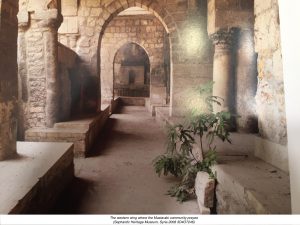
The Western wing where the Mustarabi community prayed (Sephardic Heritage Museum, Syria 2008, 3D407246)
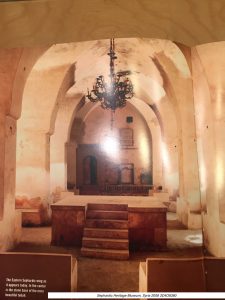
The Eastern Sephardic Wing as it appears today. In the center is the stone base of the once beautiful tebah.(Sephardic Heritage Museum, Syria 2008)
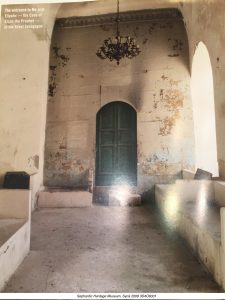
The entrance to Me’arat Eliyahu the Prophet-in -in the Great Synagogue.(Sephardic Heritage Museum, Syria 2008)
The Great Synagogue was comprised of three sections. The western wing, eastern wing and middle section which was located outdoors. The middle section and western wing were built before the eastern wing. The western wing had eight windows, each in a different shape overlooking a garden. These unique shapes corresponded with Kabbalistic ideas. Syrian authorities have since sealed these windows. The middle section was a courtyard that was open to the sky and had pillars on all four sides. The community worshipped outdoors in good weather. The eastern wing was added later to accommodate the Spanish exiles who came to Aleppo after expulsion from Spain in 1492. It is speculated that this wing was constructed during the 16th century although it may have been later. (ibid. 41)
Chief Rabbi Laniado wrote that the Great Synagogue was constructed in accordance with kabbalistic teaching. This is why it contained seven arks for storing torah scrolls and seventy two pillars. The seven arks were located in the three sections of the synagogue. Each of the seven arks had two doors at its entrance, large enough for a person to enter so he could remove the Torah scrolls within. Due to the holiness of the arks, anyone entering them would remove their shoes. (ibid. 42)
The Heichel Tekiah, the largest of the arks was located in the middle open section of the synagogue. The platform at the top of this ark was reached by climbing nine stairs. On this platform circumcisions were performed and the shofar was blown on the Jewish New Year. Another ark, Heichal Eliyahu was located in the cave of the Prophet Elijah in the eastern section. This ark was located in Me’arat Eliyahu Ha Nabi because a safe there contained four codices including the Keter Aram Soba or the Aleppo Codex. For centuries people would come to Me’arat Eliyahi Ha Nabi to light candles and pray to G-d. Women would light candles and pray there on the eve of Yom Kippur. If a person needed to take an oath it would be administered in front of the Aleppo Codex. (ibid. 46,47)
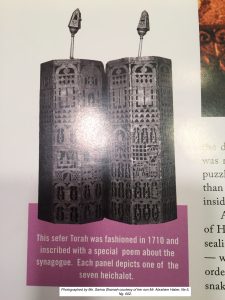
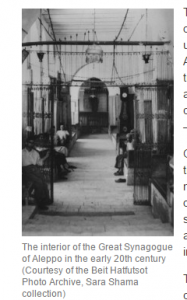
The codex, a Hebrew manuscript was hidden for centuries in the Great Synagogue where it became known as the Crown of Aleppo. It was damaged in a fire set by Arab rioters in 1947, concealed and then smuggled to the new state of Israel by the Jews of Aleppo as their community was disappearing. It was entrusted to Ben Zvi, the president of Israel. This layer bound volume of parchment folio had been kept intact for hundreds of years but a large number of pages had gone missing at the time of the fire. The manuscript is now safeguarded at the National Museum, the late president’s institute in Jerusalem. (Friedman, Matti 2012: xiv, xv). The Crown was created in the 10th century at a time when 90% of the world’s Jews lived in the lands of Islam. The book told the story of the people’s connection to G-d and their land. The five books of Torah, are the heart of the Jewish religion. The torah is read out loud in synagogue in portions beginning with the creation of the universe and ending with the death of Moses. (ibid. 26-28)
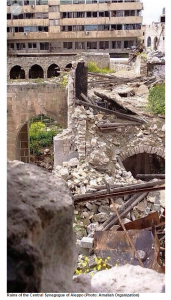 Ruins of the Central Synagogue of Aleppo (photo: Amaliyah Organization)
Ruins of the Central Synagogue of Aleppo (photo: Amaliyah Organization)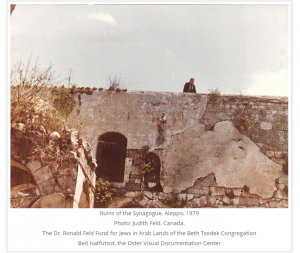

On Saturday November 29, 1947, the United Nations voted to partition Palestine and create two states, one Arab and one Jewish. While Jewish leaders accepted the proposal, Arab nations rejected it. Five Arab nations- Egypt, Iraq, Lebanon, Syria and Jordan prepared to attack the Jewish state which numbered 600,000 Jews. At this time the Arabs of Aleppo declared a strike in protest and sealed off the city on the next day, November 30th. The city where the Jewish community had lived in peace with their Arab neighbors had changed dramatically. On December 1, 1947, Arab mobs rioted and set fire to synagogues, Jewish schools, businesses and houses. The Great Synagogue, one of the targets was set aflame causing great damage. The synagogue remained standing but its roof caved in as a result of the fire. After the riots, the eastern section was restored and the community prayed there. Beginning in the late 1980’s the rest of the synagogue was restored. (The Sephardic Heritage Museum 2016: 51,52).
Page created by Carol Silvera


